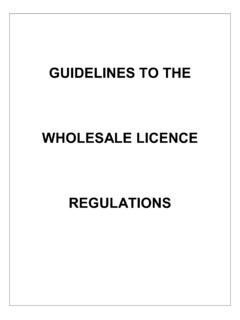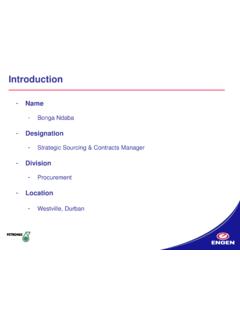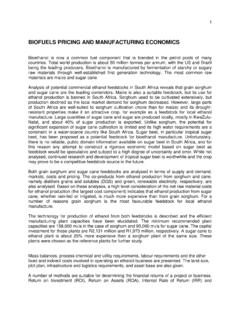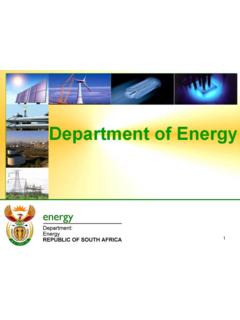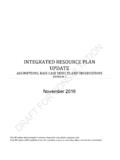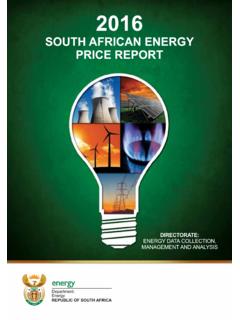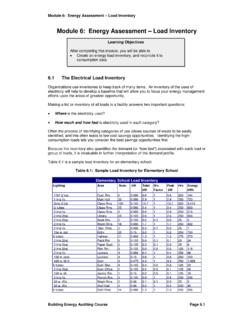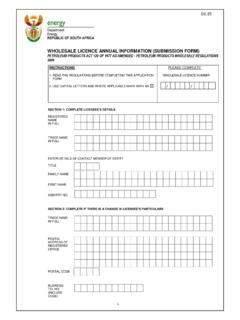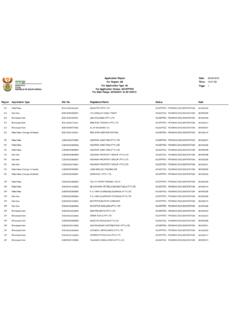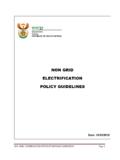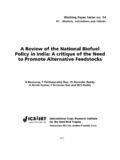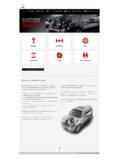Transcription of Overview of the Petrol and Diesel Market in South Africa ...
1 Overview of the Petrol and Diesel Market in South Africa between 2007 and 2016 Directorate: Energy Data Collection, Management and AnalysisCompiled by: Ms Keneilwe Ratshomo Email: Ramaano NembaheEmail: by:Department of EnergyPrivate Bag X96 Pretoria0001 Tel: (012) 406-7819/012 406 7540192 Visagie Street, c/o Paul Kruger & Visagie Street, Pretoria, 0001 Website: the greatest care has been taken in the compilation of this publication, the Department of Energy relies on data provided by various sources and is not responsible for any errors or omissions emanating as a consequence of provision of inaccurate, incorrect or incomplete data from such sources. Although all the necessary steps were taken in aligning all the internal data management processes with the South African Statistical Quality Assessment Framework (SASQAF), accreditation by Statistics South Africa for the energy statistics/data used in compiling this report has not yet been of EnergyActing Director-General: Mr T MaqubelaEnergy Policy and Planning BranchDeputy Director-General: Mr O AphaneEnergy Planning Chief DirectorateActing Chief Director: Ms Z Harber Energy Data Collection, Management and Analysis DirectorateDirector: Ms V Olifant This is the second edition, published in : 978-1-920435-11-0 Copyright ReservedDirectorate: Energy Data Collection, Management and Analysis1 FOREWORDIt gives me great pleasure to introduce the report, Overview of the Petrol and Diesel Market in South Africa between 2007 and 2016.
2 This report is based on information collected from government departments, petroleum industry and research papers, and covers a broad Overview and analysis of the South African Petrol and Diesel industry. The aim is to keep stakeholders informed about developments as well as key issues affecting the report presents the industry in a format which provides an Overview of South Africa s Petrol and Diesel Market between 2007 and 2016. This includes sources and the overall Petrol and Diesel Market dynamics, as well as the relationship between the two products. To clearly present and analyse consumption trends, this report is further divided into national and provincial Market analyses. The Department of Energy is working hard to ensure accurate, timely and reliable provision of data in its publications, and hopes that this report will become a source of reference among energy analysts in South Africa and abroad.
3 I extend my most sincere thanks and appreciation to the Energy Data Collection, Management and Analysis Directorate for the hard work that went into the compilation of this publication. I would also like to record my appreciation to all energy data providers who have helped us to accomplish the compilation of this report. Comments and inputs are welcome, and can be addressed to T MaqubelaActing Director-GeneralDepartment of EnergyOverview of the Petrol and Diesel Market in South Africa between 2007 and 20162 TABLE OF CONTENTF oreword ..1 List of Figures ..3 Abbreviations and Acronyms ..41. Introduction .. Outlook .. Legislation and regulations governing the petroleum industry ..62. Overview of the Petrol and Diesel Market in South Africa ..73. National Petrol and Diesel Market Trends .. Consumption per product type .. Petrol and Diesel consumption per trade sector.
4 Petrol and Diesel consumption per grade ..124. Provincial Petrol and Diesel Market Trends .. Petrol consumption per province .. Diesel consumption per province .. Provincial Petrol and Diesel consumption per trade Provincial Petrol and Diesel consumption per grade ..215. Conclusion ..296. References ..307. Appendix A: Data Scope ..31 Directorate: Energy Data Collection, Management and Analysis3 LIST OF FIGURESF igure 1: Supply and demand of Petrol , 2007 2016 ..8 Figure 2: Supply and demand of Diesel , 2007 3: Total number of new vehicle sales in South Africa , 2007 4: Petrol and Diesel prices, 2007 2016 ..10 Figure 5: Petrol and Diesel consumption, 2007 2016 ..11 Figure 6: Petrol and Diesel consumption in the retail sector, 2007 2016 ..11 Figure 7: Petrol and Diesel sales volumes in the commercial sector, 2007 2016 ..12 Figure 8: Consumption per grade of Diesel , 2007 2016 ..13 Figure 9: Consumption per grade of Petrol , 2007 2016.
5 13 Figure 10: Petrol sales volumes per province, 2007 2016 ..14 Figure 11: Diesel sales volumes per province, 2007 2016 ..15 Figure 12: Petrol and Diesel consumption per trade sector in the Eastern Cape, 2007 2016 ..16 Figure 13: Petrol and Diesel consumption per trade sector in the Free State, 2007 2016 ..16 Figure 14: Petrol and Diesel consumption per trade sector in Gauteng, 2007 2016 ..17 Figure 15: Petrol and Diesel consumption per trade sector in KwaZulu-Natal, 2007 2016 ..18 Figure 16: Petrol and Diesel consumption per trade sector in Limpopo, 2007 17: Petrol and Diesel consumption per trade sector in Mpumalanga, 2007 2016 ..19 Figure 18: Petrol and Diesel consumption per trade sector in the Northern Cape, 2007 2016 ..20 Figure 19: Petrol and Diesel consumption per trade sector in the North West, 2007 2016 ..20 Figure 20: Petrol and Diesel consumption per trade sector in the Western Cape, 2007 2016.
6 21 Figure 21: 93 Unleaded Petrol (ULP) consumption per province, 2007 2016 ..22 Figure 22: 95 Unleaded Petrol (ULP) consumption per province, 2007 2016 ..23 Figure 23: 93 Lead Replacement Petrol (LRP) consumption per province, 2007 2016 ..24 Figure 24: 95 Lead Replacement Petrol (LRP) consumption per province, 2007 2016 ..25 Figure 25: 500 ppm sulphur Diesel consumption per province, 2007 2016 ..26 Figure 26: 50 ppm sulphur Diesel consumption per province, 2007 2016 ..27 Overview of the Petrol and Diesel Market in South Africa between 2007 and 20164 ABBREVIATIONS AND ACRONYMS AAAutomobile Association of South AfricaBFPB asic Fuel PriceCTLCoal-to-liquidDoEDepartment of EnergyDSMLD emand Side Management LevyEIAE nergy Information AdministrationFSVF uels Sales VolumeGDPG ross Domestic ProductGTLGas-to-liquidIBLCIn-Bond-Lande d-CostLRPLead Replacement PetrolNAAMSAN ational Association of Automobile Manufacturers of South AfricaNDPN ational Development PlanNERSAN ational Energy Regulator of South AfricaOECDO rganisation for Economic Co-operation and Development OPECO rganization of the Petroleum Exporting CountriesPPMP arts per millionSAPIAS outh African Petroleum Industry AssociationSARBS outh African Reserve BankSARSS outh African Revenue ServiceStatsSAStatistics South AfricaULPU nleaded PetrolUSUnited StatesDirectorate.
7 Energy Data Collection, Management and Analysis51. INTRODUCTIONC rude oil was the world s leading fuel in 2016, accounting for about a third of global energy consumption according to BP s Statistical Review of World Energy 2017. Oil also supplies approximately 95% of the energy powering the global transport systems in the form of petroleum fuels (US EIA, 2017). Similarly, South Africa s transport system depends on petroleum fuels for almost all of its energy needs, with more than 80% of the petroleum fuels consumption made up of Petrol and Diesel (DoE, 20171). The National Development Plan (NDP) 2030 provides South Africa s vision for socio-economic growth and development. The plan recognises that the country should have adequate supply security in electricity and in liquid fuels such that economic activity, transport, and welfare are not disrupted (NDP 2030: 163). The plan envisages that, by 2030, South Africa will have an energy sector that promotes: Economic growth and development through adequate investment in energy infrastructure; The sector should provide a reliable and efficient energy service at competitive rates, while supporting economic growth through job creation; Social equity through expanded access to energy at affordable tariffs and through targeted, sustainable subsidies for needy households; and Environmental sustainability through efforts to reduce pollution and mitigate the effects of climate this context, the South African petroleum industry has evolved over the years, as seen by a change and growth in fuel grades.
8 This is not only in line with the NDP but also international standards in terms of environmental sustainability as well as evolving fuel and vehicle technology. OutlookThe future of the liquid fuel sector depends on four factors, namely, demand growth, sustainable resources and environmental constraints. The increase in demand for petroleum products will be determined primarily by the growth in the country s GDP, GDP per capita, the rate of urbanisation and population growth. Currently, around 80% of global primary energy demand is met by fossil fuels, whose growth is constrained by the finite nature of these resources. The growth in the petroleum sector will depend on the sustainability of these resources as well as the introduction of non-conventional sources, such as shale oil and gas. Due to low oil resources in South Africa , the security of supply will depend on the economic and political stability in the Organization of the Petroleum Exporting Countries (OPEC) countries, as well as the substantial investment needed in South Africa s refinery capacity.
9 The South African economy, which grew by an estimated in 2016, is expected to grow by in 2017 and 2% in 2018 as economic conditions strengthen (Treasury, 2017). This is still in line with the NDP, from which the expected public investment in infrastructure could reduce bottlenecks in transport, while stronger employment growth will contribute to increased household consumption, which in turn, will increase the demand for liquid fuels in the to the US Energy Information Administration (EIA), energy demand from the transport sector is expected to remain dominated by oil. However, the growth in transport demand for liquid fuels is anticipated to slow down post 2025, as efficiency improves and displacement by gas ramp up. Natural gas is the fastest growing alternative at per annum and is expected to overtake biofuels 1 DoE sources fuel sales volume (FSV ) data from the petroleum industry (Seven oil companies in South Africa ) Overview of the Petrol and Diesel Market in South Africa between 2007 and 20166in 2022 before reaching almost 7% of the transport Market by 2035.
10 The Market share of biofuels in the energy sector is forecast to grow from currently to 4% by 2035. The Department (DoE) is in the process of finalising the Integrated Energy Plan, which will be guided by national objectives, informed by the Energy White Paper, National Energy Act and influenced by various government policies. The Integrated energy plan is aimed at determining the best way to meet current and future energy service needs in the most efficient and socially beneficial Legislation and regulations governing the petroleum industryThe DoE oversees the development of energy policy and implementation thereof. Energy policy and its subsequent legislative and regulatory frameworks are the foundation upon which the regulator and investors make decisions and consumers make choices about which energy solution to South Africa s economy opened up following the 1994 democratic election; the new government reviewed and developed policies in the energy sector driven by international trends.
